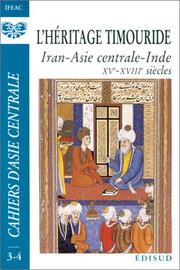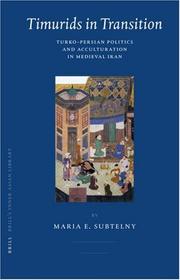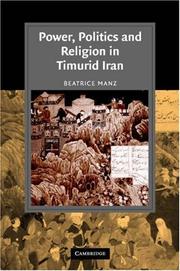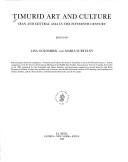| Listing 1 - 10 of 13 | << page >> |
Sort by
|
Book
ISBN: 9004401814 Year: 2019 Volume: 7] Publisher: Leiden; Boston : BRILL,
Abstract | Keywords | Export | Availability | Bookmark
 Loading...
Loading...Choose an application
- Reference Manager
- EndNote
- RefWorks (Direct export to RefWorks)
Ghiyāth al-Dīn Khwāndamīr (d. after 942/1535-6) is a Persian historian who worked for several Timurid rulers in Herat. After the capture of Herat by the Uzbeks in 912/1507 and their ousting by the Safavids in 916/1510, Khwāndamīr held no further public office there. In 927/1520 he went to Agra where he entered the service of the founder of the Mughal dynasty Bābūr (d. 937/1530) and, following the latter's death, his son Humāyūn (d. 963/1556). He died in India, where he was also laid to rest. Khwāndamīr is especially known for his Ḥabīb al-siyar , a universal history from the beginning of time until the reign of Shāh Ismāʿīl I (d. 930/1524). The present work, written at the beginning of his career, is a monument to the greatness of his first patron, the vizier Mīr ʿAlī Shīr Nawāʾī (d. 906/1501). Khwāndamīr's personal involvement in many of the events that it describes lends this work its special interest.
Timurids --- History --- Alisher Navoiĭ, --- Appreciation.
Book
ISBN: 9004662553 Year: 1992 Publisher: Leiden, The Netherlands : E. J. Brill,
Abstract | Keywords | Export | Availability | Bookmark
 Loading...
Loading...Choose an application
- Reference Manager
- EndNote
- RefWorks (Direct export to RefWorks)
The papers collected in this volume were delivered at a symposium held in Toronto, and discuss the art and culture of Timurid times. The papers cover the last decades of the 14th century and the whole of the 15th, in an area of western Asia extending roughly from the Euphrates to the Hindu Kush.
Civilization. --- Timurids --- Art, Timurid --- Iran --- Asia, Central --- Civilization
Book
ISBN: 9781848857261 1848857268 9781784531287 1784531286 Year: 2012 Volume: 1 Publisher: London ; New York I.B. Tauris Publishers
Abstract | Keywords | Export | Availability | Bookmark
 Loading...
Loading...Choose an application
- Reference Manager
- EndNote
- RefWorks (Direct export to RefWorks)
"Having monopolized Central Asian politics and culture for over a century, the Timurid ruling elite was forced from its ancestral homeland in Transoxiana at the turn of the sixteenth century by an invading Uzbek tribal confederation. The Timurids travelled south: establishing themselves as the new rulers of a region roughly comprising modern Afghanistan, Pakistan and northern India, and founding what would become the Mughal Empire (1526-1857). The last survivors of the House of Timur, the Mughals drew invaluable political capital from their lineage, which was recognized for its charismatic genealogy and court culture - the features of which are examined here. By identifying Mughal loyalty to Turco-Mongol institutions and traditions, Lisa Balabanlilar here positions the Mughal dynasty at the centre of the early modern Islamic world as the direct successors of a powerful political and religious tradition."--
Legitimation. --- Timurider --- Timurids --- Timurids. --- Historia. --- History. --- Timuriden. --- 1526-1765. --- Geschichte 1483-1707. --- India --- India. --- Indien. --- Mogul Empire --- Mogulreich. --- Mogulriket --- History
Book
ISBN: 9782251454726 Year: 2023 Publisher: Paris : Belles lettres,
Abstract | Keywords | Export | Availability | Bookmark
 Loading...
Loading...Choose an application
- Reference Manager
- EndNote
- RefWorks (Direct export to RefWorks)
"Féroce conquérant, à l’instar de Gengis Khan, provenant des confins de l’Asie centrale et de la mythique Samarcande, Amir Timour ou Tamerlan est le fondateur éponyme d’une dynastie majeure : les Timourides (1370-1507). Après sa mort, cette dynastie a dominé l’Est du monde iranien et turco-iranien, et produit l’une des plus brillantes cultures du monde islamique : le fameux « quinzième siècle timouride », combinaison politico-culturelle unique de la tradition turco-mongole et de la tradition iranomusulmane.Dans cette synthèse de référence, Maria Szuppe éclairel’originalité de la civilisation timouride : structure de l’État, organisation du pouvoir et de la société, vie économique, religieuse, littéraire et artistique, mais aussi vie quotidienne sont ici racontées au moyen des sources originales, principalement en langue persane, et des recherches les plus récentes dans les domaines historiques, littéraires et archéologiques. Chronologies, cartes et illustrations viennent les compléter."
Timurides (dynastie) --- Taymur ibn Tragay Bahadir --- Timurids --- Timur, --- Iran --- History --- Kings and rulers --- Timurids. --- Taymūr ibn Trāġāy Bahādir, --- Tīmūrides (dynastie) --- Asie centrale --- Asia, Central
Book
ISBN: 1474437435 9781474437431 Year: 2019 Publisher: Edinburgh : Edinburgh University Press,
Abstract | Keywords | Export | Availability | Bookmark
 Loading...
Loading...Choose an application
- Reference Manager
- EndNote
- RefWorks (Direct export to RefWorks)
Islamic illumination of books and manuscripts. --- Art, Middle Eastern. --- Timurids --- History.

ISBN: 2857449550 Year: 1997 Publisher: Aix-en-Provence Edisud
Abstract | Keywords | Export | Availability | Bookmark
 Loading...
Loading...Choose an application
- Reference Manager
- EndNote
- RefWorks (Direct export to RefWorks)
Architecture, Timurid --- Art, Timurid --- Islamic architecture --- Timurids --- Civilization --- Asia, Central --- Iran --- Mogul Empire --- Civilization. --- History

ISBN: 1281921696 9786611921699 9047421604 9789047421603 9004160310 9789004160316 9781281921697 6611921699 Year: 2007 Volume: v. 19 Publisher: Leiden Boston Brill
Abstract | Keywords | Export | Availability | Bookmark
 Loading...
Loading...Choose an application
- Reference Manager
- EndNote
- RefWorks (Direct export to RefWorks)
How did the the descendants of Tamerlane, collectively known as the Timurids, make the transition from a nomadic empire to a sedentary polity based on the Perso-Islamic model , and what effect did the process of transition have on their Turko-Mongolian customs and identity? This volume seeks to answer these questions by utilizing the Weberian concepts of the “routinization” of charismatic authority and the patrimonial household state. Focusing on the period of the last Timurid ruler, Sulṭān-Ḥusain Bayqara (1469–1506), the author examines the impact of the introduction of Persian modes of bureaucratic administration on the evolution of Timurid government and describes the development of the agrarian economy of the eastern Iranian province of Khorasan through the Islamic institution of the pious endowment. Based on an exceptionally broad range of sources in Persian, Arabic, and Turkic languages, the book provides a new paradigm for understanding the Timurids within the framework of post-Mongol history and offers fresh insights into Turko-Persian relations and the problem of acculturation in medieval Iran.
Acculturatie. --- Timoeriden --- Timurids --- History. --- Iran. --- Iran --- Economic conditions. --- History --- Politics and government. --- Tīmūrides (dynastie) --- Acculturation --- 15e siècle --- 1256-1501

ISBN: 0521865476 9780521865470 9780511497483 9780521153461 0511269757 9780511269752 0511268645 9780511268649 0511269315 9780511269318 9780511270314 0511270313 9786610750658 6610750653 0511497482 0521153468 1107169968 1280750650 0511320779 0511268017 Year: 2010 Publisher: Cambridge Cambridge University Press
Abstract | Keywords | Export | Availability | Bookmark
 Loading...
Loading...Choose an application
- Reference Manager
- EndNote
- RefWorks (Direct export to RefWorks)
Beatrice Forbes Manz uses the history of Iran under the Timurid ruler Shahrukh (1409-1447) to analyse the relationship between government and society in the medieval Middle East. She provides a rich portrait of Iranian society over an exceptionally broad spectrum - the dynasty and its servitors, city elite and provincial rulers, and the religious classes, both ulama' and Sufi. The work addresses two issues central to pre-modern Middle Eastern history: how a government without the monopoly of force controlled a heterogeneous society, and how a society with diffuse power structures remained stable over long periods. Written for an audience of students as well as scholars, this book provides a broad analysis of political dynamics in late medieval Iran and challenges much received wisdom about civil and military power, the relationship of government to society, and the interaction of religious figures with the ruling class.
Gesellschaft --- Politik --- Religion --- Timuriden --- Timurids --- Geschichte --- History. --- Tīmūrides (dynastie). --- Iran --- Iran. --- Timuridenreich. --- Politics and government. --- Politique et gouvernement --- History of Asia --- anno 1400-1499 --- Arts and Humanities --- History

ISBN: 9004095314 Year: 1992 Volume: 6 Publisher: Leiden : E.J. Brill,
Abstract | Keywords | Export | Availability | Bookmark
 Loading...
Loading...Choose an application
- Reference Manager
- EndNote
- RefWorks (Direct export to RefWorks)
Art, Timurid --- Timurids --- Art timouride --- Timurides --- Congresses --- Congresses. --- Congrès --- Congrès --- Asia, Central --- Iran --- Asie centrale --- Iran --- Civilization --- Congresses --- Civilization --- Congresses --- Civilisation --- Congrès --- Civilisation --- Congrès
Book
ISBN: 3895003883 Year: 2005 Volume: 7 Publisher: Wiesbaden : Reichert,
Abstract | Keywords | Export | Availability | Bookmark
 Loading...
Loading...Choose an application
- Reference Manager
- EndNote
- RefWorks (Direct export to RefWorks)
China --- Iran --- Chine --- History --- Relations --- Histoire --- Tīmūrides (dynastie) --- Timurids --- History. --- Asie centrale --- Asia --- Relations extérieures --- Commerce extérieur --- Commerce --- Tīmūrides (dynastie). --- Relations extérieures --- Tīmūrides (dynastie). --- Commerce extérieur
| Listing 1 - 10 of 13 | << page >> |
Sort by
|

 Search
Search Feedback
Feedback About UniCat
About UniCat  Help
Help News
News